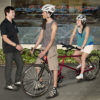Tandem-Specific Geometry
The racy handling inherent to a great road single doesn’t translate well to a tandem. When builders graft a single bike’s geometry onto a tandem the resulting bike becomes a bit skittish. And while some captains are initially captivated by a tandem that feels faster, the very real downside of this illusion is “stoker steer”—where the slightest lateral move of the stoker causes an undesired alteration in the tandem’s direction. Although “quick steering” and “single bike handling” are great sounding claims, conscientious builders will eventually realize that a bicycle with two riders deserves a more sophisticated geometry.
Compared to single bikes or tandems mischaracterized as “fast,” Santana’s tandems have a bit more fork rake. Increased rake acts to dampen stoker-induced steering—allowing a captain to experience a greater degree of steering control with far less effort. An additional cause for Santana’s superior handling is a bottom bracket height lower than that used by all other manufacturers, but not so low as to cause you to scrape a pedal. The difference may be less than 5mm, but it is enough to further improve the bike’s stability. Lower bottom bracket heights also increase straddle clearance, making it easier to fit riders to a Santana.
By building our bikes with a touch less bottom bracket height and a bit more fork rake, control is enhanced, allowing the captain to concentrate on pedaling (or sightseeing) instead of steering. A bike with confidence-building stability allows duos to maintain a predictable line while riding in a group, and inspires them to descend hills with greater speed. And on longer rides, where fatigue becomes a factor, a bike that’s easier to control enables higher average speeds and earlier finishing times. Finally, in the event of a road hazard, mishap or blowout, control of a tandem is most easily maintained on a Santana—stable bikes prefer to stay upright.







